I CARE INTERVIEW
11trn Naira Oil Subsidy: Why Buhari’s Regime Spent So Much
Fuel subsidy has a long history in Nigeria,with every successive government ,from president Olusegun Obasanjo regime to the late President Musa Yar’adua down to president Jonathan all have had to deal with fuel subsidy.
However, according to the Petroleum Products Pricing Regulatory Agency (PPPRA),the Federal Government under former presidents Olusegun Obasanjo, Umaru Yar’Adua and Goodluck Jonathan spent N8.94 trillion or $23.05 billion on petrol subsidy, the amount, calculated at current exchange rate, was spent between 2006 and 2015.
However, between 2015 and 2022, the present administration headed by President Muhammadu Buhari has spent a total of N11tn ,thus surpassing what the combined regime of Obasanjo, Yar’adua and Jonathan spent from 2006 to 2015. What were the factors responsible for this huge difference? Would the nation have spent this much on subsidy if the refineries were working? Can the Petroleum Industry Act (PIA) change the narrative? MMS Plus spoke with Mr. Johnson Chukwu, an investment analysts and Chief Executive Officer (CEO), Cowry Asset Management Limited.
Chukwu advanced reasons and possible factors that could have brought about the huge fuel subsidy spending of the Buhari administration, positing that the dysfunctional state of the nation’s refineries ,adverse effect of the Russian – Ukraine war and other micro and macro economic factors are possible contributory factors to the high subsidy spending of the Buhari’s administration. Chukwu spoke with Frank Odinukaeze.Enjoy it.
A look at the subsidy regime in the country, shows that Obasanjo,Yar’adua and Jonathan spent N8.9trillion or $23.5billion on subsidy from 2006- 2015. But president Buhari,within 8 years, that is, 2015- 2022 has spent close to N11trillion on subsidy. What could be the factors responsible for this astronomical rise?
I don’t know. But the only thing you should know is that -the question should be : What figures were they reporting as the transaction under Obasanjo, Jonathan and Ya’Adua? One factor has been the average consumption of 65 million liters a day , which is about 18.23billion Naira a day currently. So if that’s the case, the major factor will be the volume of consumption and then the price of crude at that time,and whether they were later refineries and whether we were sourcing everything that we were consuming. Currently, none of the refineries is working. So we are currently importing everything we are consuming. That is one factor. And then it is alleged or reported that our consumption now is 65 million liters a day. And is that not the volume it was under Jonathan or under Yaradua? And then in the current scene, we have seen an elevated price of crude averaging more than 100 dollars per barrel. I think the present state is about 113 dollars per barrel in the first seven months of the year. So those are the factors that will explain the reported amount of subsidy. So the question is that, if there are any issue to it, interrogate the amount that we are consuming. That is the key thing .
Looking at subsidy, the cost of subsiding fuel in 2020 was put at 450billion Naira but in 2022, alone the total cost of subsidy in January and February was put at 392 billion Naira, according to NNPC data. So what do you make of this?
Like I said, the answer is still the same issue. What brought the volume and the amount reported? And what was the general price of refined petroleum products during the period? Of course, the war in Russia and Ukraine led to sharp increase in the price of diesel,AGO as well as price of refined petroleum products.
And the other factor is,what volume were we consuming? Once you know the amount of volume consumed, and the international price of refined products ,then it will explain whatever figure that is quoted or reported as subsidy.
Despite oil being a major source of revenue, the oil sector is behind other sectors in terms of GDP contribution. How much impact can the petroleum Industry Act ( PIA) bring to change the narrative?
Well, a couple of things. If the PIA,when it is is fully developed, will lead to the development of the down stream sector , particularly the non-working refineries. So, if you have improvement in the refineries and volumes of crude refined, we will not only be refining within the local consumption, there will be increase in the export of refined petroleum products .
So,we are going to have a more domestication of the petroleum industry which is under the one we have now which is basically crude oil export.
Once we domesticate that,that will bring additional improved economic activities into the economy. So, value will be created and the GDP contribution of the oil and gas sector,will increase.
What we have largely now is an oil sector that has no beneficiation. There is no addition of value to the country. But if we have refineries, you are going to have value addition to the country, by creating more jobs
You will even have other additional values like petrochemical industries, paint industry and other industries that get some of their raw materials from the refinery industry.
With the growing population of Nigeria at average of 2.6% per annum, according to World Bank report in 2020, do you think it will be economically wise to sustain or remove oil subsidy in Nigeria?
I think the issue of removal of oil subsidy is no more debatable. It is no more – whether it is right or not. I think we have gone far beyond that. In the first place,the petroleum industry which you and I is discussing is a critical component of the Petroleum Industry Act( PIA). The subsidy will no longer be there. The PIA will become effective from July ,2023.So I don’t think there is still any debate on whether we should remove subsidy or not. There is an extant law that already took out the subsidy,
How do we come out of this subsidy challenge, when our refineries are not functional?
Well, I don’t know. The refineries have not been functional for the past couple of years. And you not taking out the subsidy has not made the refineries to function. So I think it is no longer a matter of whether we continue or not. At the point where we are, the law has been passed, to make the subsidy increase stoppable. And the law did not make provision that the refineries must function before the subsidies are taken out.
So,I think we have gone beyond that. The issue is for the government to have the courage to implement the law as it’s written.
Do you see the government having the political will to actualize the PIA?
The three leading candidates have said they would remove subsidy. And that takes care of that. The current government says subsidy will go by July 2023. It is becoming very unsustainable. You can’t spend N6-7trillion of your revenue on subsidy,at a time of high capital expenditure and budget deficit.






